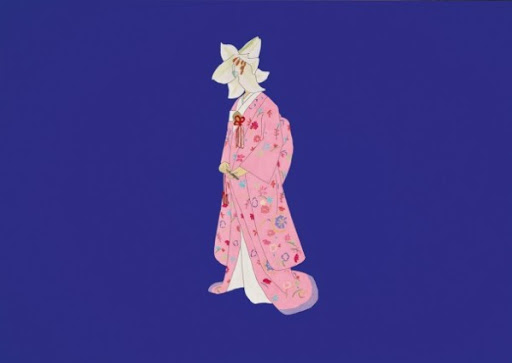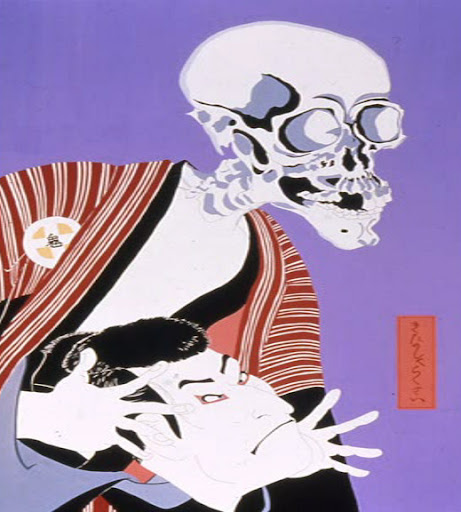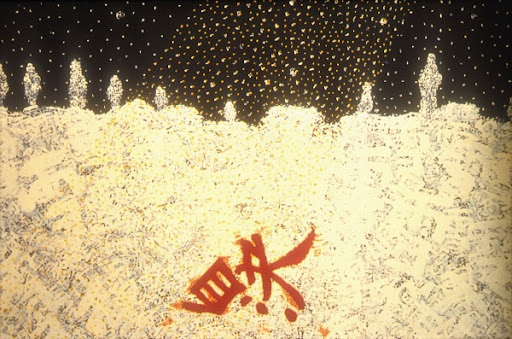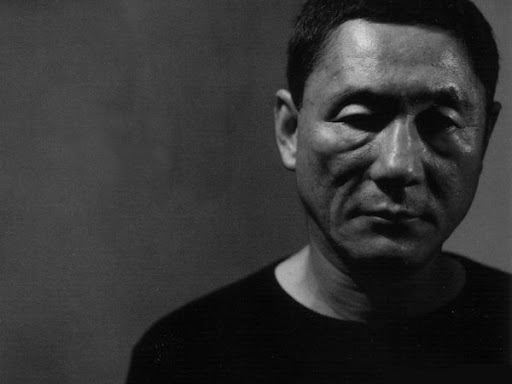
Twenty or so minutes into Hana-bi, and I swear I was ready to bail. Cheesy soundtrack, a shutdown cop uttering not even a word, and a hospitalized wife on her way home to die. Yay. But I didn't bail, and I am soooooooooo glad I wasn't foolish enough to make that horrible mistake.
Hana-bi is one of the most heart-felt films I've seen in years, and even though I'll gladly plead ignorant on other Kitano films, if this is representational of the quality of his work...well...I'm hooked. Hana-bi reminded me of Chang-dong Lee's Secret Sunshine, in that quietness played such a major role, and they were both made from the heart onto film. Man...this film is sooooooo damn good. Watch it.

From Mark Freeman at Senses of Cinema:
Of all the filmmakers in contemporary Japan, Takeshi Kitano is perhaps the most instantly recognizable, and certainly the most commercially and critically successful. This recognition reached its zenith with his recent film, Hana-bi (1997), a film which distinguished itself by its striking visual style and kinetic interplay of movement and inaction. The spaces Kitano evokes in Hana-bi, the aural, visual and narrative elisions, are coupled with the frantic violence and fast cutting of the action sequences which imbue the film with both a meditative and distinctly contemporary feel. Yet in many ways the film reflects the style and use of space of one of Japan's most significant filmmakers of the past, Yasujiro Ozu. Space expands in Ozu's films, the traditional 180 degree perspective becomes 360, and time seems to stretch and snap, extending scenes to reveal empty spaces, and eliding others in a divergence from the classical cause and effect mode of narrative. It is for this non-classical style, and his concentration on scenographic space and emptiness that the cinema of Ozu is frequently linked to a particularly religious aesthetic.
So if indeed Ozu is, as critic and filmmaker Paul Schrader asserts, "the most Japanese of directors", in what context do we place the contemporary Japanese cinema of Kitano? What impact or legacy has Ozu left in terms of narrative and space, particularly in a time when the popularity of classical narrative so relentlessly excludes such meditative and unconventional use of spatial/temporal relations? The recent success of Hana-bi offers an interesting and profound counterpoint to the lessons of Ozu. If we indeed accept Ozu's place as a symbol of a gentle, traditional Japanese ethos, Kitano's film appears a stark contrast, a film that seems firmly grounded in a stylised world of ultra-violence and unstable values. Interestingly, however, Kitano's film reflects much of the Ozu tradition, yet blends his use of narrative space with contemporary approaches to action and movement. So whilst Hana-bi confronts us with scenes that completely contradict Ozu's approach, such as Nishi's (Takeshi Kitano) attack on the Yakuza, or the shooting of Horibe (Ren Osugi), Kitano also employs very similar techniques in terms of visual, aural and diegetic space. Clearly the "old" Japan lives on in contemporary Japanese cinema. In many ways, a true appreciation and understanding of the contemporary cinema of Kitano stems from this recognition of its roots in the cinema of Ozu, whose spatial and temporal world refuses to concede to narrative emptiness.

With Kitano's contemporary style in mind (and in particular the hospital sequences in Hana-bi), consider an early scene from Ozu's 1958 film Equinox Flower. In it we see a length of corridor, at the end of which is mounted a painting of Mount Fuji. People walk past this corridor, some hurrying, others taking their time. No one at any stage walks towards the camera - they all pass by this space and vanish. The passing parade slows to a trickle, then ceases completely, leaving the space empty. Ozu keeps the camera rolling - the corridor, bereft of people, continues its existence long after the people have gone. Such is the world according to Ozu, a place where people come and go, where objects are used, admired, or are ignored. What remains, though, is the space; what is absent is clearly as important as that which is present. Kathe Geist identifies this as the mu, "an emptiness that is nevertheless full of possibilities", and the ma, a " kind of moving mu", where space is inhabited and deserted, such as the corridor in Equinox Flower. This interplay of mu and ma are central to the transcendental approach identified by Schrader, and reinforces the traditional Japanese ethos where, like the Japanese art of ikebana, space is central to meaning. The empty corridors of Equinox Flower and Tokyo Story (Yasujiro Ozu, 1953) for example, encourage us to perceive these passers by as transitory. They exist for only that moment, and their destinations are hidden from us. The lengthy pause after the last person strolls past emphasises both the void and provides a sense of fullness and weight. What we see is the space - it possesses an eternality that the people clearly do not. The bridges, corridors and rooms Ozu leaves deserted will continue with or without the people who populate them, and thus humanity does, in a sense, play out scenes on an eternal stage.
The emptiness of the hospital in Hana-bi echoes this purpose. With his wife dying, and Nishi bereft on a number of levels, Kitano's concentration on the emptiness of the corridors both follows the Ozu tradition, and acts as a resonant metaphor. These narrative pauses ostensibly do nothing to further the narrative, yet they allow us an opportunity to consider what we have seen, and to dwell on the emptiness before us. In Equinox Flower, Hirayama (Sin Saburi) is left alone in an empty room as both his wife and daughter scurry in and out. The rapidly moving figures contrast with the solitary stillness of Hirayama and create both an aesthetic and diegetic impact. What we are witnessing is the preparations for the next scene, as the stage is filled and emptied, changed and organised to deliver the next sequence of dialogue. The normality of this sequence is significant, yet classical systems would elide such urbanity - it establishes nothing, fails to further the narrative, and appears to be, in radio parlance: "dead air". What Ozu (and Kitano by association) achieves by revealing these lingering moments is to articulate a very clear rhythm, to slow down and force us to consider, to reflect. It is not his aim to charge through the narrative; indeed, the plots of both Tokyo Story and Equinox Flower, for example, are very slight. But through space Ozu creates power - and as we also see in Kitano's film, when nothing happens, plenty is happening.

In the classical narrative form, transitions between scenes generally resort to images establishing locale, or serve some other clear diegetic purpose, yet both Ozu and Kitano shirk the direct linkage in these transitional spaces. Rather than close ups of cars or exteriors of coffee shops, Ozu's transitions offer far more meditative material; they take on the forms of art or painting or sculpture - a vase or building, a boat or road, a pillow or chair. These divergent moments again create a "space" in the narrative, a gap of what seems to be non-narrative. There is no development or propulsion of the plot, yet these sequences contribute to our sense of the film, its rhythms and tones. Following Tomi's (Chieko Higashiyama) death in Tokyo Story, we are shown an empty street, empty train tracks and an empty pier, all of which we have seen previously in the opening sequences, where these spaces were utilised. Thus, through this transition, Ozu confirms that Tomi is dead, void of life, as are the now deserted spaces from the film's opening. Thus, whilst classical narrative places things in frame to further propel the narrative, Ozu aims to exclude things to serve the same purpose. And whilst much has been made of the interior spaces of Ozu, his use of 360-degree space, and the tatami positioning of the camera, little attention has been paid to his use of exterior spaces. Tokyo Story hinges on the journey of the parents from rural Onomichi to the urban complexity of Tokyo, as well as further journeys to Atami and Osaka. This spatial gulf, of course, is not just physical - an emotional space has distanced the family, with the ungrateful children only too keen to shuffle them off to Atami, to keep the parents occupied and out of their way. But it is out in these open spaces that the characters face their most profound moments. Encased in the warrens of their homes, the characters grapple with each other, reposition and define themselves. Like the journey taken by Nishi and Miyuki (Kayoko Kishimoto) in Hana-bi, out in the open and contrasted with vast mountains and lakes and endless skies, Ozu's characters are forced to reflect and confirm their place in the cosmos, to appreciate what they have.
Add to these narrative elements the visual and aural spaces that Ozu evokes throughout his films, and a clearer picture of his influence on Kitano is apparent. The almost direct to camera framing of his characters suggest a formal intimacy between protagonist and audience, evoking a sense of visual orchestration that leaps beyond the diegetic world. In aural terms, people generally only speak when they have something to say in Ozu's films, remaining silent when they don't. In Equinox Flower, the final moments centre on Hirayama's wife who sits formally in silence, elated by the news of the impending reconciliation of father and daughter. Such silences help give meaning to dialogue, just as the transitions give importance to scenes. In contrast, those who insist on breaking silences, such as Mrs. Sasaki (Chieko Naniwa) in Equinox Flower, become figures of fun; her incessant chattering exists in opposition to the sober silences of the other characters. Of all the elements Kitano has utilised in Hana-bi, Ozu's visual and aural spaces are the most apparent, drawing a clear line from the traditions of the past to the cinema of contemporary Japan.

So with Ozu's unconventional use of space and traditional Japanese aesthetics, where in this framework fits Kitano's Hana-bi, a contemporary story of a quiet, taciturn policeman given to sudden and brutal outbursts of violence? Made some forty years after Ozu's Equinox Flower, and the product of a society radically different from that featured in Ozu's world, it is in some ways heartening to detect this legacy. There is no denying Kitano's world is light years away from the families of Ozu. This is a world of violent acts and moral quagmires, where action takes a central role in the construction of the film. And unlike Ozu, there are clear causal links in the narrative with all threads resolved at the film's conclusion. Yet in temporal/spatial terms, Kitano's film echoes much that has been established by the films of the past.
Whilst the narrative of Hana-bi is essentially classical, it is delivered in a spatially fractured, dislocated fashion. Kitano reveals elements of his story like puzzle pieces, disclosing information in dislocated flashbacks, forcing us to reorient ourselves within the narrative, as we do after the elision of key scenes in Ozu's films. Nor is it mere accident that Miyuki spends much of her time trying to complete a spatial puzzle. We too are fitting the pieces together, shifting and reorganising events in the narrative to create the correct "shape". An early scene involving this puzzle composition ends with a shot of empty dinner plates and the disjointed pieces of the puzzle. Like the scene from Equinox Flower, space is both created and filled in this scene, yet ultimately the "problem" of space is unresolved. The completion of the puzzle comes just prior to the film's conclusion, and with the problem of space resolved, as with Tomi's death in Tokyo Story, further space is then created by Nishi's final act.
As if to reinforce the spatial relationship with Ozu, Kitano employs similar framing devices, similar transitions. In Hana-bi's opening sequence, Nishi attacks two young men for leaving rubbish on his car. Rather than convey the violence of this scene in long shots, Kitano isolates each character, framing them individually, so that they become separate, removed from each other, facing the camera in the disarming tradition of the past. Nishi's face, obscured by dark glasses and frozen in an impassive expression, typifies the void of Ozu. Whilst the space is filled, there is nothing to be learnt, there is no progress or movement within that stillness. These shots suggest a staged portraiture, a kind of human ikebana where space and form work together to create meaning. Ozu's influence is also evident in the transitions between scenes. Many of these directly incorporate works of art - the art of the wheelchair bound Horibe, whose paintings meld the plant and animal worlds. Flowers assume new forms, erupting into the shapes of vegetables, or the faces of beasts; others show families watching fireworks or disappearing into snowstorms. These images, like the transitions of Ozu, create space, deflect dramatic impetus, and yet still impact directly on our understanding of the diegetic world. The title of the film itself continues this floral theme. The Japanese hanabi translates in English to fireworks, the separation by the hyphen in the title breaks the meaning down into a truer form: hana (flower) and bi (fire). In the final scenes of the film, Miyuki is seen watering dead flowers, a futile attempt to bring life back into that which has gone. Thus, like Ozu's Equinox Flower and the ikebana aesthetic, Kitano's Hana-bi explores the interconnection of form and void, of life and lack.

But perhaps the most significant of the remnants of Ozu that exist in this contemporary drama is Kitano's effective use of aural space. Hana-bi is indeed a film consumed by silence, a quiet that is sporadically broken by apparently aimless conversations or outbreaks of vicious bloody violence. The stillness of the scenes between Nishi and his wife produces palpable, eloquent silences. The void exists, and doesn't, with Ozu's ma aesthetic pervading these scenes. Nishi himself barely utters a word throughout the film, and Miyuki merely says "Thank you. Thank you for everything" in the films closing moments. Nishi's robbery of the bank is also completed in silence, through the conceit of a surveillance video.
The robbery leads us to the inevitable employment of physical space; like the parents in both Equinox Flower and Tokyo Story, the bereaved parents of Hana-bi set out on a journey, travelling to Mt. Fuji, walking along beaches and lakes. Water seems to be a recurrent theme in these outside spaces; they are places of resolution and commitment, inspiring both pleasant nostalgia and the sad recognition of the passing of time. Whilst Hirayama and his wife enjoy a final day with their daughters at Hakone Park, and Shukichi (Chisu Ryu) and his wife recognise the truth at Atami, Nishi and his wife too reach their peak on the beach. The silence that envelops this sequence creates a void, an aural space that is broken by the two gunshots which signify their death. The camera remains on the waves, the beach, and the sea, which continues its motion. Like the eternal spaces of Ozu, in Kitano's world there is a permanence, a transcendence to the spaces that surround us, and the people that populate them come and go, with the only constant being the space left behind.
Clearly over the forty year bridge from Ozu to Kitano, a legacy has been maintained. The eternal spaces of Ozu are echoed in the final shots of Hana-bi, his silences forming the basis of the relationship between Kitano's characters. The lingering transitional spaces reappear in Kitano's stairwells and hospital hallways, in the melancholy paintings by the crippled Horibe. The isolated framing of Ozu occurs in the stylised opening, and Kitano also utilises an Ozu-esque near address to camera during a sequence at a car yard. That Ozu is an influence is clear, but it would be a mistake to dismiss Hana-bi as simple homage. What Kitano does achieve is a tremendous melding, or meshing of forms. The traditions of the past are reflected throughout the film, yet the influences of the present are also evident. People are shot in agonizing slow motion, blood gathers in huge pools on tiles, chopsticks are jabbed into eyes with unexpected fury. This is not the world of Ozu, but the world of the "new" Japanese cinema. Kitano's power lies in his ability to unite these two worlds, these opposing forces that rely so heavily upon each other. In the tradition of Ozu, space, void and stillness are irrevocably tied to form, movement and change. With the films of Yasujiro Ozu and Takeshi Kitano, this relationship of space and form create the cinematic equivalent of ikebana, the space defines, shapes and instructs the form. Thus, they both create a thing of beauty and colour and shape and movement out of the void; they create fireworks.

Technical Information:
Title: はなび/Hana-bi/Fireworks
Year: 1997
Country: Japan
Director: Takeshi "Beat" Kitano
Source: DVD5 Retail
DVD Format: NTSC
Container: .iso + mds
Size: 4.32 GB
Length: 1:43:11
Programs used:
Resolution: 720x480
Aspect Ratio: 16:9
Video: MPEG2 @ ~5200 kb/s
Frame Rate: 29.97 fps
Audio: Japanese- Dolby AC3 5.1 @ 640 kb/s
Subtitles: Japanese, Chinese, English
Menu: Yes
Video: Untouched
DVD Extras: Trailer, Behind the Scenes (no subs)

(Use JDownloader to automate downloading)
Fireworks Megaupload Links


